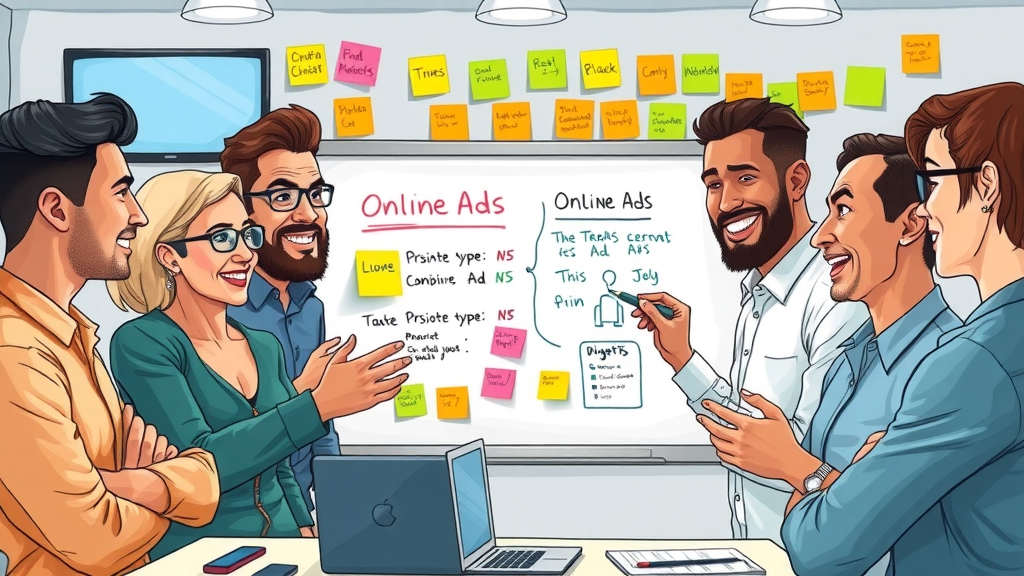Did you know businesses lose up to 35% of their online paid ads budget every year, all because of bad targeting and ineffective strategies? If you’ve felt the sting of ad spend going nowhere, you're not alone. Most companies funnel thousands into paid advertising and wonder why they aren't seeing real, measurable results. The good news? There’s a proven way to maximize your ROI and finally make every online ad dollar count. Read on to discover what truly works and how you can start driving sales with smarter online paid ads—no more wasted money.

Startling Facts About Online Paid Ads: Setting the Stage
Most businesses dive into the world of online paid ads expecting instant leads and surging sales. Yet, over one-third of every ad dollar is wasted. Inefficient ad campaigns, weak audience targeting, and uninspired creative often drain your budget before seeing results. Today's digital landscape is filled with google ads, display ads, social media ads, and even amazon ad formats—each promising high conversions but seldom delivering unless optimized correctly. The reality is, the majority of online ad campaigns underperform due to outdated tactics and blind faith in "set-it-and-forget-it" strategies. It's time you stop falling victim to this widespread inefficiency and learn how smart marketers actually drive sales, improve ad spend, and capture the attention of their ideal customers.
"Businesses waste an estimated 35% of their online paid ads budget due to poor targeting and weak strategy. Don’t let it happen to you."
What You'll Learn About Online Paid Ads
- Understand why most online paid ads fail
- Identify the types of paid advertising that actually drive sales
- How to optimize your google ads, social media ads, and more
- Strategies to maximize ad spend ROI
- Secrets to building a landing page that converts
The Truth About Online Paid Ads: Why Traditional Paid Advertising Fails
The Real Cost of Online Paid Ads and Ad Spend
There’s often a vast gap between expected outcomes and reality when it comes to online paid ads. Business owners frequently focus on increasing ad spend rather than optimizing for performance and cost-efficiency. Without careful ad spend monitoring and ongoing adjustments, campaigns quickly eat into budgets with little return. For instance, while search ad and display ad costs can vary widely across industries, the lack of precise targeting and message relevance leads to low conversion rates—even as impressions and clicks rise. Analyzing true return on investment (ROI) requires factoring in not only the direct costs of paid advertising but also opportunity costs: every wasted dollar could have been invested in high-performing ad channels, smarter google ads campaigns, or designing a more effective landing page for conversions.
Moreover, as platforms like social media and amazon ad networks grow in sophistication, so do the nuances in campaign setup and measurement. Mistakes in media ad formats, mismatched audience segments, and lack of cohesive brand messaging compound to drive up expenses and reduce ad effectiveness. Thus, businesses must go beyond the surface and understand that strong ROI depends on strategic planning, monitoring key metrics, and adapting quickly to data insights. If not, even the largest ad budget can disappear with little impact on your sales funnel or brand awareness.

Common Pitfalls: From Google Ads to Social Media Ads
Many businesses fall into predictable traps when it comes to paid ads. One major misstep is neglecting ongoing optimization—assuming that what worked last quarter will continue to deliver leads in today's fast-evolving digital marketplace. With constantly shifting algorithms and consumer behaviors on social media ad platforms, yesterday’s winning strategy can become today’s money pit. It's common to overbid on broad search engine keywords, use uninspired creatives, or launch ads on the wrong media platform, resulting in poor click-through rates and wasted impressions. Another frequent error is failing to match the ad format to the target audience: a video ad designed for engagement performs poorly if delivered to a demographic that responds better to simple text or carousel ads on social media.
Additionally, many campaigns rely on vanity metrics like impressions and clicks, neglecting deeper analysis like true cost per acquisition and the quality of leads generated. Many businesses get seduced by the promise of broad exposure from display ads or media ads, but without focusing on campaign goal alignment, your advertising campaign risks irrelevance. It all ties back to understanding the unique dynamics of amazon ad, google ads, and social media ads platforms—and committing to ongoing refinement. Smart marketers continually test, iterate, and ensure that every dollar of ad spend works harder toward genuine business growth.
Why Your Target Audience Ignores Most Online Ad Campaigns
Your ideal customers are bombarded by thousands of ads daily—so much so, that most have developed ‘banner blindness’ and unconsciously skim past even the most striking media ads, display ads, and search ad placements. The main reason most online paid ads get ignored is a disconnect between creative messaging and audience intent. If your ad doesn’t resonate or fails to address a direct pain point, it gets lost in the endless scroll. Research shows that simply appearing in search results or blasting a media ad across thousands of feeds doesn’t equate to results if the content isn’t relevant, timely, and valuable.
Furthermore, the ad experience often fails to inspire action: slow-loading landing pages, generic offers, and too much focus on product features instead of benefits lead to instant abandonment. Today, attention is the currency—and to earn it, you need deeply personalized, context-rich advertising that speaks directly to your target audience. Integrate audience insights, behavioral data, and creative experimentation for online paid ads that stand out and, more importantly, drive sales, not just empty clicks.
Table: Breakdown of Online Paid Ads Spend vs. ROI by Industry
| Industry | Avg. Paid Ads Spend | Avg. ROI | Conversion Rate | Main Channel |
|---|---|---|---|---|
| eCommerce | $8,000/mo | 4.1x | 3.5% | Google Ads, Amazon Ad |
| B2B SaaS | $12,000/mo | 3.2x | 2.1% | LinkedIn, Display Ad |
| Local Services | $2,500/mo | 2.8x | 8.0% | Google Ads, Social Media Ad |
| Healthcare | $7,500/mo | 3.9x | 4.3% | Display Ad, Native Ad |
| Retail | $10,000/mo | 4.4x | 5.5% | Google Ads, Social Media Ads |
Types of Online Paid Ads: What Actually Drives Sales?
Overview of Types of Paid Advertising (Google Ads, Social Media Ads, Display Ads, Video Ads, Native Ads, Amazon Ad)
With a dizzying array of types of paid advertising at your disposal, it’s crucial to match ad formats with your business objectives and target audience behavior. The most popular are google ads (search ads, display ads, shopping ads), social media ads (such as Facebook, Instagram, LinkedIn), video ads on platforms like YouTube or TikTok, native ad placements mimicking editorial content, and robust amazon ad solutions for ecommerce. Each unique avenue offers different strengths: search ads capture high-intent queries, display ads heighten brand awareness, social media ads nurture communities and engagement, while amazon ad campaigns put your product front and center when customers are ready to buy.
To maximize your paid advertising ROI, tailor your message and creative assets to align with the native format of each media platform. What works for a social media audience may fall flat in search engines, and a static image display ad might struggle against the fast pace of video ads. Best-in-class campaigns track which channel delivers the best results for your business, adjust targeting and bidding accordingly, and regularly test new ad format innovations. Always keep your finger on the pulse of where your potential customers spend their time online.
Search Ads vs. Media Ads: How Search Engine Platforms Compare
Choosing between search ads and media ads comes down to campaign goals and audience mindset. Search engine platforms like Google Ads help you capture active intent: users are searching for solutions, making search ads ideal for driving immediate sales or qualified leads. In contrast, media ads—including display ads and social media formats—are designed to build brand awareness, re-engage audiences, and nurture interest over time, reaching potential customers while they're scrolling through news feeds or browsing favorite sites.
For businesses with long sales cycles, leveraging both can be powerful: capture hot leads through google ads and reinforce messaging with display ads and native ad placements. By monitoring conversion rates, cost per click, and audience interaction across each channel, you can strategically allocate your ad spend without stretching your budget thin. Savvy marketers understand that blending media ads with high-intent search ads unlocks broader reach and better results for your advertising campaign.
When to Use Social Media Ads Versus Display Ads
Deciding between social media ads and display ads depends on where your target audience spends their time and how they interact with brands. If you’re looking to build a loyal community, drive real-time engagement, or retarget existing followers, social media ads (across platforms like Facebook, Instagram, Twitter, and LinkedIn) are often your best bet. These ads thrive on interactivity and can be finely segmented for lookalike audiences, making them excellent for promoting events, product launches, or limited-time offers.
In contrast, display ads are ideal when you want broad brand exposure and to cast a wide net over users browsing different sites on the web. These ads excel at keeping your brand top-of-mind with eye-catching visuals and retargeting campaigns—working even when the potential customers aren’t actively searching for your products or services. Smart advertising campaigns often blend both approaches, delivering targeted offers on social media while using display ads to reach users at key touchpoints throughout their buyer’s journey.

Optimizing Online Paid Ads: Strategies That Guarantee ROI
Target Audience: Sharpening Paid Advertising for Real Results
The single most important factor in making your online paid ads work is knowing—and reaching—the right target audience. All too often, ad campaigns fail because they cast too wide a net or chase demographics that were never likely to convert. Effective paid advertising starts with research: analyze customer data, segment by behavior, interests, and past engagement, and build detailed audience profiles. Platforms like google ads and amazon ad offer powerful targeting tools, from keyword intent for search ads to audience interests and lookalikes for social media ads.
Once segmented, continually refine your audience targeting using conversion data and insights from campaign reports. Exclude segments that don’t convert, double down on high-performing ad groups, and use tools like retargeting and sequential messaging to nurture potential customers through multiple touchpoints. With every iteration, your paid ads become more efficient and results-driven, ensuring your ad spend goes directly toward driving sales and not into the digital void.
Creative Elements That Make Paid Ads Clickable
No matter how advanced your targeting or how big your budget, your creative assets are what truly stop the scroll. The most effective paid ads use compelling headlines, punchy calls-to-action, and striking visuals tailored to each ad format. Successful advertisers experiment with short videos, animated graphics, and much-tested copywriting to find what resonates. For video ad and display ad placements, invest in professional design and consistent branding. Meanwhile, the best social media ad creatives engage viewers with storytelling, humor, or value-driven content that feels native to the platform experience.
Always test multiple creative variants (A/B testing) and refresh ad images and copy regularly. Modern advertising campaign tools even allow for dynamic creative optimization, automatically serving the best-performing ad combinations to each segment of your target audience. Bottom line: don’t just “set and forget”—continually experiment to find the messages and visuals that get your potential customers to act.

Landing Page Excellence: Turning Clicks into Customers
An often overlooked but critical piece of the online paid ads puzzle is the landing page. You might generate plenty of clicks from a high-performing ad, but without a dedicated, persuasive landing page, conversion rates plummet. A winning landing page is laser-focused, aligned with your offer, and eliminates distractions—moving visitors directly toward your conversion goal. Key elements include a clear headline, persuasive subtext, a compelling call-to-action, and trust signals such as testimonials, client logos, or guarantees.
Ensure your landing page loads quickly, looks great on mobile devices, and delivers exactly what your ad promises. Use analytics to identify drop-off points and A/B test different versions to improve conversion rates. Remember, every online ad dollar wasted on a bad landing page is a missed opportunity to drive sales—so invest time where it matters most!
Conversion Tracking and Attribution for Better Online Paid Ads Decisions
If you can’t measure it, you can’t improve it. That’s why conversion tracking and attribution are foundational to effective online paid ads strategy. Start by setting up pixel tracking, UTM parameters, and conversion goals on your website and within your ad platforms. This allows you to see which ad campaigns, media ads, or even specific display ad creatives are driving the most valuable actions—be it form submissions, sales, or calls.
Attribution models help you understand which touchpoints truly influence conversions throughout the customer journey, informing smarter budget allocation and bid strategies. Use the insights to shift ad spend from underperforming channels to high-converting campaigns, ensuring every dollar works towards your sales targets. The result? Data-driven growth and consistently improving ROI for your online paid ads.
Table: Top 5 Must-Track KPIs for Any Advertising Campaign
| KPI | Description | Why It Matters | Ideal Benchmarks |
|---|---|---|---|
| CTR (Click-Through Rate) | Percentage of ad impressions that result in clicks | Indicates ad relevance to the target audience | 2–5% |
| Conversion Rate | Percentage of users taking the desired action after clicking | Measures landing page and ad creative effectiveness | 2–8% |
| CPC (Cost Per Click) | Average cost paid for each ad click | Helps manage ad spend efficiency | $0.50–$3.00 |
| CPA (Cost Per Acquisition) | Cost to acquire a customer or lead | Determines campaign profitability | Varies by industry; aim for <2x CLV |
| ROAS (Return on Ad Spend) | Revenue earned for every dollar spent | Measures campaign ROI | 3x+ |
Smart Budgeting for Online Paid Ads & Ad Spend Efficiency
Ad Spend Myths vs. Facts: How Much Should You Invest?
A myth that plagues new advertisers is the belief that more ad spend equals better results. In reality, intelligent budgeting is about starting small, testing, then scaling what’s proven to work. Too often, businesses invest heavily in a media ad or splashy new amazon ad campaign without first understanding core KPIs or audience behavior. The best practice is to set clear objectives, test multiple ad formats, and only expand budget for campaigns with clear ROI.
Fact: Smart advertisers monitor spend daily, swiftly reallocating budget from underperforming ads to high-converting ones. With features like automated bidding, negative keywords, and A/B testing available in top platforms like google ads and social media ads, you can squeeze maximum value from every dollar. The focus must always be on ad spend efficiency—not just spending more, but spending smarter to truly drive sales.
List: Budget-Friendly Paid Ads Campaign Tips
- Set clear goals before spending
- Use negative keywords
- A/B test creatives on google ads and social media
- Automate bidding (when appropriate)
- Focus on high-performing keywords
How to Adjust Your Paid Ads Strategy Without Wasting Money
Making impactful changes to your online paid ads campaign doesn’t require a massive budget overhaul. The secret is in ongoing agility: monitor campaign metrics weekly, flag underperforming keywords or creatives, and pause what isn’t working. Effective advertisers set up alerts for key KPI drops and routinely split-test landing pages, headlines, and images for all ad formats. This constant iteration is what separates top-performing brands from those still throwing money at the wall.
Be prepared to shift ad spend between channels—if a display ad campaign costs too much per conversion, reinvest in a higher-performing search ad or video ad. Always put ROI first, doubling down on platforms and messages that demonstrably drive sales. With the right strategy in place, you'll find that your budget stretches further, your acquisition costs drop, and your business growth accelerates—without burning cash on the wrong approaches.

Watch this short explainer video to see real-world advertising campaign dashboards, before-and-after campaign results, and visual examples of optimized ad creatives for desktop and mobile—demonstrating how strategic online paid ads can transform your ROI. (Video not shown in text format.)
Real-World Success Stories: Paid Advertising That Drives Sales
"After switching our strategy, our paid ads ROI increased by 200%. The difference? Focusing on the right channels and precise targeting." — Digital Marketing Expert
Success is attainable with the right strategy, as evidenced by countless businesses who rethought their ad spend, honed in on their target audience, and adapted quickly to results. Targeting, creative, and cross-channel synergy make true ROI growth possible—no matter the industry. The best way to learn is not only through expert tips but also by seeing proven results in action.
Case Study: Using Google Ads and Social Media Ads to Drive Sales
A local retail chain invested heavily in both google ads and social media ads, yet saw stagnant results for months. By conducting deep audience segmentation, optimizing ad creatives, and improving landing page messaging, their conversion rates tripled. Critically, the brand realigned ad spend from broad display ads to targeted search engine keywords and platform-specific video ads. This tailored approach drove a 200% ROI increase within a quarter—proving that maximizing online paid ads is about focus, not just funds.
Continuous testing and a commitment to analytics transformed a struggling ad account into a success story. The keys? Constant learning, agility, and always keeping an eye on which advertising campaign metrics mattered most. If they can do it, so can you.
List: Best Innovations in Paid Advertising Platforms
- AI-powered targeting (google ads, amazon ad)
- Smart audience segmentation
- Interactive video ad formats
- Retargeting on social media and display ads

People Also Ask: Popular Questions about Online Paid Ads
What is online paid advertising?
Online paid advertising refers to any digital media ad campaign where a business pays to display content or offers across search engine results, social media platforms, websites, or apps. Formats include google ads (search ads, display ads), social media ads, and video ads, all designed to reach a specific target audience and drive customers toward actions like purchases, signups, or inquiries.
How to get $500 Google Ads?
Google frequently offers promotional credits for new advertisers. In many regions, if you spend $500 on google ads, you may receive $500 in bonus ad credits. Be sure to check current promotions and eligibility rules before starting your paid advertising campaign. These incentives can help stretch your initial budget while learning what works for your business.
Can you actually get paid to see ads?
Some social media, video ad, and online ad platforms do pay users small incentives to view ads—primarily for market research. However, these opportunities are limited and usually not lucrative. Most often, businesses invest in paid ads to gain exposure to their potential customers, not the other way around.
Do we really see 4000 ads a day?
Estimates suggest individuals are exposed to thousands of ads daily, including display ads, media ads, search ads, social media ads, and native ad impressions. However, the vast majority are unconsciously ignored or filtered out. This makes it more important than ever for your online paid ads to stand out with relevance and compelling creative designed specifically for your target audience.
FAQ: Your Top Online Paid Ads Questions Answered
How do online paid ads compare to organic traffic?
Online paid ads provide instant visibility and can trigger fast results, while organic traffic is acquired through SEO and content marketing—building momentum over the long term. Paid ads are ideal for time-sensitive promotions, product launches, or filling the top of your sales funnel. However, relying solely on ads without building an organic content foundation may limit sustainable growth.
What are the best ways to optimize google ads for higher ROI?
Regularly review google ads search terms and apply negative keywords. Continuously test ad headlines, visuals, and calls-to-action for each ad campaign. Split-test landing pages, use automated bidding strategies, and monitor core KPIs. Focusing ad spend on high-converting keywords rather than broad match terms dramatically increases ROI.
Which paid advertising channel is best for ecommerce?
For ecommerce brands, google ads (Shopping campaigns), amazon ad solutions, and targeted social media ads (especially retargeting) deliver the best results. Combine channels based on where your potential customers are in the buying journey, from initial interest to final conversion, then finetune with ongoing data insights.
How do you accurately measure ad spend ROI?
Track campaign costs, conversion events, and total revenue through robust analytics tools. Use conversion tracking and attribution models to map the full customer journey. Divide the revenue generated by total ad spend to calculate ROAS (Return on Ad Spend) and optimize future campaigns for even better performance.
Key Takeaways: Online Paid Ads Done Right
- Stop overspending by choosing the right types of paid ads for your goals
- Focus your paid advertising budget on channels proven to drive sales
- Optimize landing pages and creative for your target audience
- Track and analyze every campaign to maximize ad spend
- Stay updated with advertising campaign technology and market trends
Conclusion: Take Control of Your Online Paid Ads Success
With a strategic approach, you can stop wasting money and transform online paid ads into a powerhouse for growth. Act now and take control of your advertising success.
 Add Row
Add Row  Add
Add 




Write A Comment